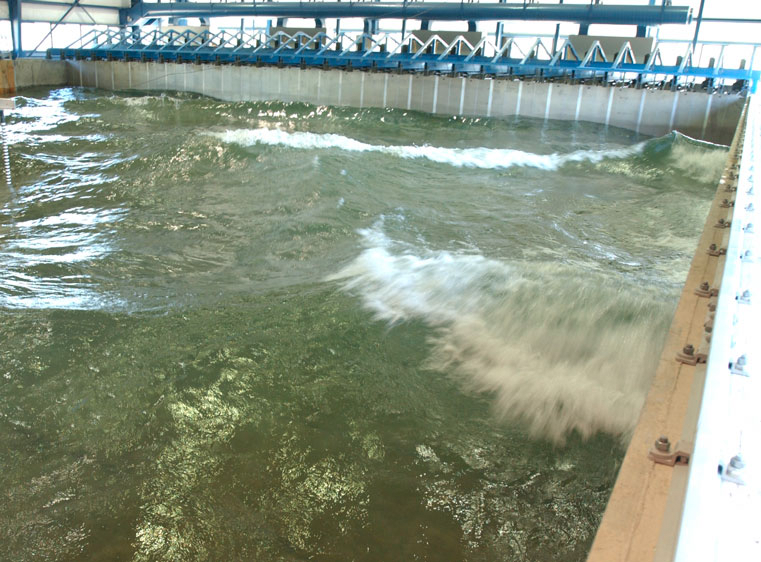The NHERI CWST-EF, as part of the O.H. Hinsdale Wave Research Laboratory, is operated by the College of Engineering and located on the main campus of Oregon State University in Corvallis, Oregon. The NHERI CWST-EF is among the largest experimental facilities for coastal research worldwide and one of the few located at an academic institution. The two-acre building houses two signature facilities: the Large Wave Flume (LWF) and the Directional Wave Basin (DWB) as well as work/office space for the director, staff of 3 full-time technicians, and several graduate students, plus common office space and conference rooms to support visiting researchers, industry clients, graduate students, and undergraduate research students.
The Large Wave Flume (LWF) measures 104 m long and 3.7 m wide, with 4.6 m high walls and a maximum still water depth of 2.74 m (maximum still water depth for tsunami generation is 2 m). The LWF is the largest of its kind in the US and among the top 10 worldwide in terms of system performance. The wavemaker is a piston-type with a programmable hydraulic actuator capable of generating repeatable regular, irregular, tsunami, and user-defined waves. The wavemaker is operated with periods ranging from 0.5 to 10+ seconds and with a maximum wave height of 1.6 m at 4 seconds. Active reflected wave cancellation is provided by a wave profile measurement at the wave generator, serving as an input to wave board velocity control. This simulates the open boundary condition at sea, minimizing reflection off the wave generator and maintaining the quality of the incident wave environment. The LWF is used to induce and measure wave forces on constructed and natural ocean features at large Reynolds numbers, providing high resolution wave structure interactions with minimum distortion due to viscous effects.
The Directional Wave Basin (DWB) is 48.8 m long and 26.5 m wide, with 2.1 m high walls and a maximum still water depth of 1.37 m (maximum still water depth for tsunami generation is 1 m). It is constructed as a reinforced concrete reservoir, with a 15 cm wall and floor thickness. A vehicle access ramp, 3 m wide, allow equipment and materials to be transported conveniently into and out of the basin. A bridge crane with a capacity of 7.5 tons spans the length and width of the DWB to position the models and to facilitate instrumentation. Unistrut® inserts are placed in rows at 1.22 m spacing to affix specimens, and instrumentation throughout the basin. The DWB wavemaker is a multidirectional vertical-hinge piston-type with 30 independently-programmable servomotor-driven points and 29 paddles. Each drive point has a maximum stroke of 2 m and a maximum velocity of 2 m/s. The wavemaker is capable of generating repeatable regular, irregular, tsunami, and user-defined waves, and has the same active reflected wave cancellation system as the LWF.

